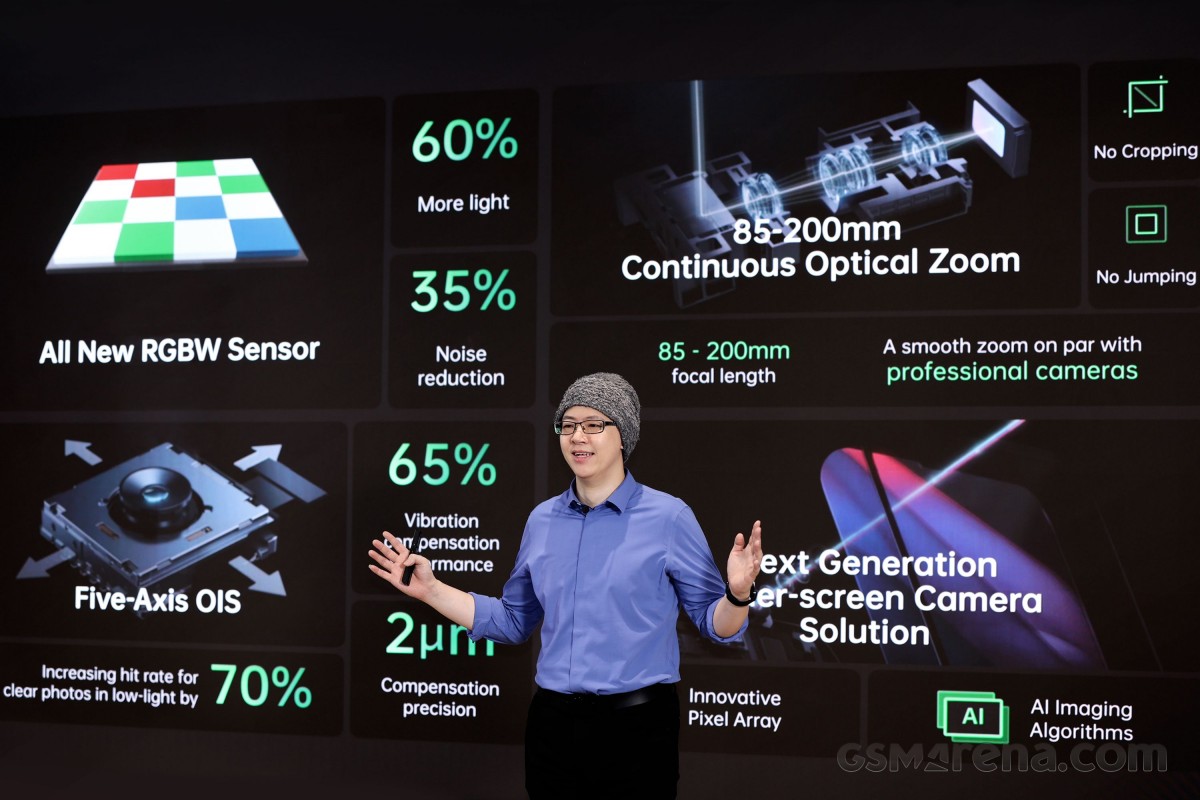Oppo organized the Oppo Future Imaging Technology Event 2021 disclosing several developments akin to smartphone imaging technology. The emphasis was on enhancements of algorithms, modules, and sensors. Oppo has actually been putting its focus on the development and self-advancement of fundamental imaging technology to allows its users to “capture the beauty in life with ease.”
Oppo’s new additions include its next-generation RGBW sensor, Five-axis OIS technology, next-generation under-screen camera with a series of proprietary AI algorithms, and the 85-200mm Continuous Optical Zoom. Making use of all of these, the company has reportedly accomplished a surge in smartphone imaging technology including zoom capability, light sensitivity, stabilization, future product form factor pre-research, etc.
Talking about the next-generation RGBW sensor, it is said to remarkably enhance the light sensitivity, all thanks to an added white sub-pixels(W), DTI technology, and a 4-in-1 pixel algorithm, all of which allow to capture 60% more light in comparison to earlier sensors. It is also said to deduce noise 1 by up to 35%, hence produce bright and clear images even in low-light conditions.
Next-generation RGBW sensor
Made with state-of-the-art manufacturing and processing technology, the new RGBW sensor requires more computing power in order to execute complex algorithms while maximize data extraction using white pixels. The proprietary 4-in-1 pixel algorithm is known to extensively increase color performance and reduce color inaccuracy and moiré patterns. The DTI pixel isolation technology avoids sub-pixel crosstalk, hence boosts the quality of an image.
The next-generation RGBW sensor also produces expressive portraits in photos and videos. It enhances skin, texture, and contrast to do so. The sensor is slated to ship with Oppo products as of Q4 2021.
85-200mm Continuous Optical Zoom Lens
Oppo has released the new 85-200mm Continuous Optical Zoom with support for super-smooth zoom. The module endorses G+P (glass + plastic) lens technology courtesy of two ultra-thin, high-precision aspheric glass lenses that cardinally increases optical effects such as reducing stray lights. The Five-axis OIS promises brighter photos.
There is a tunnel magnetoresistance sensor aka TMR sensor that allows lenses inside the camera module to move with an added precision and stability. Similarly, the new guiding shaft motor escalates the dynamic tilt at which the lens system can be navigated while upholding Continous Optical Zoom at higher magnifications.
All these additions support Continuous Optical Zoom at equivalent focal lengths amidst 85mm and 200mm to capture sharp images at every magnification level including up close and personal portraits to far-away landscapes, without having to crop at all. This allows users to experience smooth transition across the zoom range with image quality that is comparable to a professional camera. The technology negates general problems such as white balance inaccuracy, color bias, jumping, and more.
Five-axis OIS
The five-axis OIS from Oppo allows the system processor to receive movement data from the gyroscope, hence analyze and break it into its respective components using algorithms. Later on, the data is passed to two moveable components — lens and image sensor, which are driven by ball-bearing motors and shape memory alloys respectively.
When the movement is rather small, images are fixed via lens-shift OIS including horizontal and vertical shifting. Similarly, when the amplitude of the movement is comparably large, sensor-shift OIS is utilized too that includes horizontal and vertical shifting along with rolling and algorithm compensation, hence achieve stabilization in five-axis of space.
Now, this lets a maximum stabilization age of +3°, i.e. 3 times more than traditional OIS technology on mobile devices. However, the sensor can also shift with 2μm precision. The proprietary algorithm technology can greatly enhance color performance, stability, and clarity thereby augmenting the vibration compensation performance by up to 65%.
The five-axis OIS will commercially be released in Oppo products starting Q1 2022.
Next-generation under-screen camera
Oppo has developed algorithms itself that are said to support next-generation under-screen cameras to produce the perfect balance between screen and camera quality.
The next-generation under-screen camera features the advanced pixel geometry that ensures a 400-PPI high-quality display right in the under-screen camera area.
Leveraging new design and transparent wiring, a smooth visual experience is ensured. Each pixel circuit drives just 1 pixel (“1-to-1”) in the screen, which on top of a precise algorithmic compensation technology, precisely controls the brightness and chromaticity of the screen with a deviation of around 2% and screen lifespan of around 50%.
Moreover, Oppo talks about its U.S. Research Institute to have developed several imaging AI algorithms that include anti-condensation, diffraction reduction, HDR, and AWB to refine the imaging quality of the under-screen camera. The AI diffraction reduction model has reportedly been trained to utilize several thousands of images to control issues, which are raised due to diffraction at the light source, hence allows users to capture natural images.
On a closing note!
Oppo is known for its global R&D capacities all around the globe with 6 research institutes, 5 R&D centers, and tens of imaging labs across the world. Some of these include the Imaging lab in Hyderabad, India, and the Imaging Lab in Yokohama, Japan, both created a range of self-developed imaging technologies for the Oppo Reno series.
Oppo promises to target on implementing self-developed imaging technologies while strengthening relations with industry partners to provide users with an enhanced imaging experience.







